
- English
- Français
Professeur de mathématiques appliquées à l'université Abdelmalek Essaadi, coordinateur du Master Tourisme Responsable et Développement Humain à la faculté des sciences de Tétouan. Expert dans le domaine du patrimoine naturel et culturel au conseil européen, auteur de plusi...
Voir l'auteur ...Doctorante à l'Université Abdelmalek Essaadi et cadre chercheur à l'Instance Nationale de l’Évaluation auprès du Conseil Supérieur de l’Éducation, de la Formation et de la Recherche Scien...
Voir l'auteur ...Poverty in Morocco has been traditionally measured using monetary approach (World Bank, 1993; World Bank 2000; High Commission of Planning, 2006). Yet measuring poverty by ‘unidimensional’ approach does not capture the multiple aspects that involve the issue of poverty. Such an approach defines “poverty” as being below the minimum level necessary to meet basic income.Nevertheless,the consumption pattern varies from one person to another; therefore exceeding the poverty line level of income does not necessarily guarantee the satisfaction of his/her minimum needs. Furthermore, various studies note that a large proportion of poor people measured by the multidimensional approach are not considered monetary poor and vice versa (Alkire & Kumar, 2012; Ruggeri-Laderchi, Saith & Stewart, 2003). “Poverty can mean poor health, inadequate education, low income, precarious housing, difficult or insecure work, political disempowerment, food insecurity, and the scorn of the better off” (Alkire, 2011).
Unlike monetary poverty, there are very few studies that treated multidimensional poverty in Morocco. As an example, we would like to note the work entitled “The multidimensional approach to poverty measurement: Case of Morocco” (Bouhadi et al, 2012) that adopted the Alkire and Foster approach to poverty measurement (2007) and the statistical methodology of step-by-step for Multiple Correspondence Analysis (MCA).
In our work, we are using the Alkire and Foster approach to poverty measurement (2010) to calculate multidimensional poverty and vulnerability in the Moroccan regions according to the new regional division. We highlight regional inequalities in terms of multidimensional poverty but also the contribution of different components of multidimensional poverty to regional poverty and vulnerability
We consider the Multidimensional Poverty Index (MPI) which is a measure of acute global poverty, developed by the Oxford Poverty and Human Development Initiative (OPHI), with the United Nations Development Programme’s Human Development Report Office (Alkire and Santos 2010, 2014; UNDP 2010). It is one element from the multidimensional poverty measures; called the Adjusted Headcount Ratio (M0), proposed by Alkire and Foster (2007, 2010), with a particular selection of dimensions, indicators and weights.
Developed by Alkire and Santos in 2010, the MPI is an Adjusted Headcount Ratio which identifies multiple deprivations at the household level within the same three categories similar to the UNDP’s Human Development Index (HDI): education, health and standard of living. There are two variables for health: malnutrition, and child mortality. The education dimension consists of two indicators: years of schooling and school attendance. Then, the standard of living consists of six indicators: type of cooking fuel; access to an improved sanitation; access to safe drinking water; access to electricity; type of flooring and ownership assets.Each of the three main dimensions is equally weighted (one third each). So each indicator of health and education dimension is weighted 1/6. Each indicator of standard of living is weighted 1/18.
To identify the “multidimensionally poor”, the deprivation scores for each indicator are summed to obtain the household deprivation score, c. A cutoff of 33.3 percent, which is equivalent to 1/3 of the weighted indicators, is used to distinguish between the poor and the non-poor. If the deprivation score is 33.3 percent or greater, that household (and everyone in it) is multidimensionally poor (Alkire & Santos 2010). Households with a deprivation score greater than or equal to 20 percent and less than 33.3 percent are considered to be near multidimensional poverty. Households with a deprivation score of 50 percent or higher are severely multidimensionally poor.
Table 2 presents the estimated MPI, multidimensionally poor headcount (H) and average deprivation (A) in 2004, 2007 and 2011. Results show that there has been a decline in national MPI between 2004 and 2007 from 0,139 to 0,048. This was due to a decrease in the percentage of poor by 17.9 points from 28.5 percent to 10.6 percent. Note that in 2007, we have less multidimensionally poor people but with more deprivations. Indeed, the intensity of deprivation among the poor has increased from 38.1 percent in 2004 to 45.3 percent in 2007, which means that the average poor person experienced deprivations in more than 45% of weighted indicators. In 2011, MPI has increased to reach 0.069.The intensity of poverty has slightly decreased to 44.3 percent, but the proportion of multidimensionally poor people has climbed to 15.7 percent.In addition, 12.6 percent of the Moroccan population was considered vulnerable to multidimensional poverty in 2011, and 4.9 percent of the population was living in severe poverty.
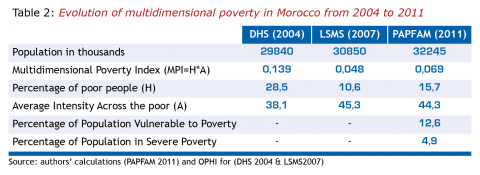
The major contributor to poverty is education
Once the MPI has been computed, we decompose it into its components. We can conclude that in 2011, the major contributor to poverty is education (45%), followed by living standards (33%) and health (22%). Concerning vulnerability, deprivation in education dimension contributes by 55% while deprivations in living standards and health contribute respectively by 36% and 8%. This finding is supported by the result of the 2015 Human Development Report published by the United Nations Development Programme (UNDP) that shows that Morocco lost 45.8 percent of his HDI largely because of the inequality in education, followed by the inequality in income (23 percent) and then health (16.8 percent).
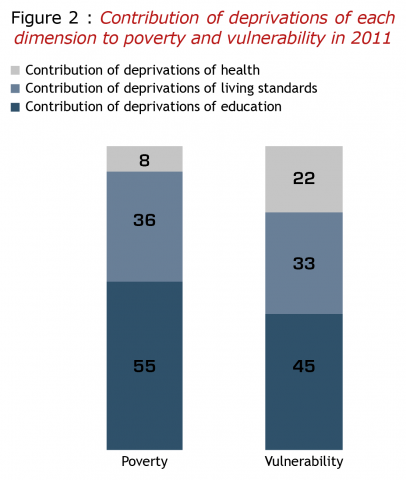
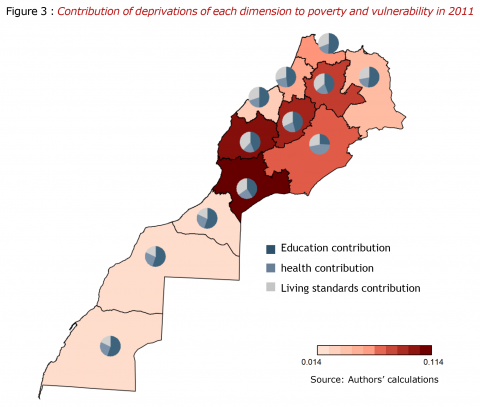
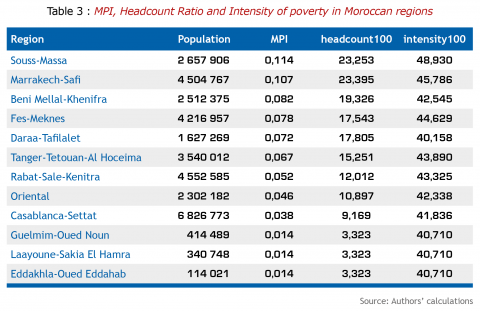
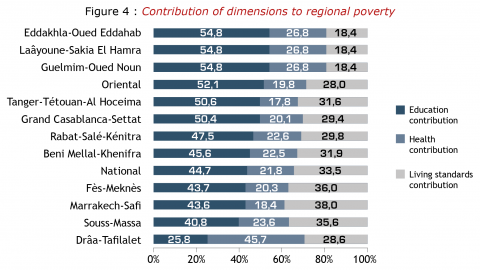
Figure 3 depicts the distribution of multidimensional poverty across Moroccan regions in 2011 and the contribution of education, health and living standards to multidimensional poverty for each region.
Table 3 sorts regions from the poorest to the least poor and provides an overview of the percentage of poor people and the intensity of their deprivations.
It can be seen that Souss-Massa is the poorest region with a Multidimensional Poverty Index equal to 0.114; that more than 23.2% of multidimensional poor people and that the average of deprivations reaches 49%. In Marrakech-Safi, the situation is not better as MPI is about 0,107, multidimensional poor people represent 23.4% of the population and the value of poverty intensity attains 46%. Beni Mellal-Khenifra comes after with a MPI equals to 0.082 and 19.3% multidimensional poor people, who experience 42.5% intensity of deprivations. Fes-Meknes and Daraa-Tafilalet follow by MPIs equal to 0.078 and 0.072 respectively, the percentage of individuals that are multidimensionally poor and the intensity of deprivations reach respectively 17.5% and 44.6% in Fes-Meknes and 17.8% and 40.1% in Daraa-Tafilalet. In Tanger-Tetouan-Al Hoceima, the percentage of individuals that are multidimensionally poor reaches 15.2% (0,067 for MPI), 12%in Rabat-Sale-Kenitra (0,052 for MPI), 10.9% (0.046 for MPI)in oriental and 9% (0.038 for MPI)in Casablanca-Settat .Southern regions (namely Guelmim-Oued Noun, Laayoune-Sakia El Hamra, Eddakhla-Oued Eddahab) are the least poor areas with a percentage of multidimensional poor people that does not exceed 3.3% (0.014 for MPI).Concerning the intensity of poverty, results show that there isn’t a considerable variation across regions; indeed, all regions show an average of deprivation’s level that exceeds 40%,meanwhile the difference between the poorest region (Souss-Massa) and the least poor region(South) is only about 8.2 point.
Analyzing the contribution for each dimension to multidimensional poverty among regions shows that, except for Draa-Tafilalet where health contributes most to multidimensional poverty (45.7% against 25.8% for education and 28.6% for living standards), deprivation on education is the major contributor to multidimensional poverty in all regions, followed by deprivation in living standards and health in the third rang.
Concerning vulnerability, Figure 5 reports the rates of vulnerability among regions. Similarly to the average of poor people, a higher rate of vulnerability is observed in Marrakech-Safi with 15.1% multidimensional vulnerable people.
Tanger-Tetouan-Al Houceima and Oriental come second, showing 14.6% and 14.3% respectively, followed by Fes-Meknes (13.9%), Souss-Massa (12.5%), Rabat-Sale-Kenitra (11.9%), Beni-Mellal-Khenifra (11.3%), Casablanca-Settat (10.7%) and Daraa-Tafilalet (10.4%). The southern region containing Guelmim-Oued Noun, Laayoune-Sakia El Hamra and Eddakhla-Oued Eddahab experiences the lowest level of vulnerability which is about 8.3%.
By examining figure 6, we can see that except for Daraa-Tafilalet where standards of living contribute most to vulnerability, schooling is the highest contributor to vulnerability in all regions, followed by standards of living and health. We can also observe that the shares of education’s contribution and living standards’s contribution to vulnerability are higher than those to poverty.
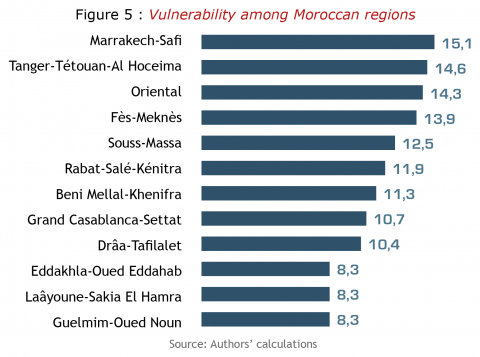
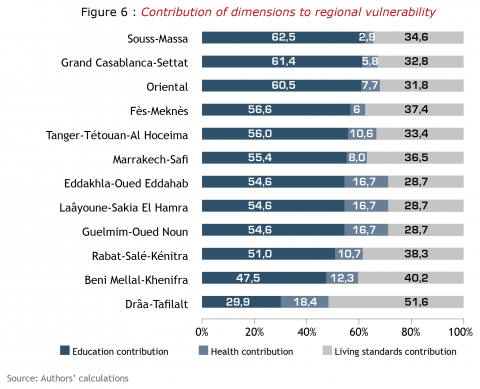
Conclusions
We calculated in this paper the multidimensional index of poverty for Morocco according to the new regional divisions. We showed that, nationally, multidimensional poverty has fallen between 2004 and 2007 and has known an increase in 2011 and that there are relevant disparities among regions in terms of multidimensional poverty in 2011. Decomposing multidimensional poverty, our results display that education represents the main contributor to both poverty and vulnerability either in national level or regional one.
According to this findings, it is strongly recommended to implement a policy to fight poverty, that would especially target the poorest regions and focus on improving education.
References